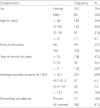3. Hotez P, Fenwick A, Savioli L, Molyneux D. Rescuing the “bottom billion” through neglected tropical disease control. Lancet. 2009; 373:1570–1576. DOI:
10.1016/S0140-6736(09)60233-6. PMID:
19410718.
4. Girma H, Getenet B, Zeleke M. Prevalence of intestinal parasites among food handlers at cafeteria of Jimma University specialized hospital, Southwest Ethiopia. Asian Pac J Trop Dis. 2017; 7(8):930–933. DOI:
10.12980/apjtd.7.2017D7-20.

5. Aklilu A, Kahase D, Dessalegn M, Tarekegn N, Gebremichael S, Zenebe S, Desta K, Mulugeta G, Mamuye Y, Mama M. Prevalence of intestinal parasites, salmonella and shigella among apparently health food handlers of Addis Ababa university student's cafeteria, Addis Ababa. Ethiopia BMC Res Notes. 2015; 8(1):4–9. DOI:
10.1186/s13104-015-0972-8.
6. World Health Organization (WHO). Prevention and control of intestinal parasitic infections. [Technical report series no. 749]. Geneva: 1987.
7. Anjum W, Kalasker P, Bhaskar K. Prevalence of intestinal parasites and its associated socio-demographic factors among the food handlers of Bagalkot city, Karnataka, India. Int J Community Med Public Heal. 2017; 44(1):1–4.

8. Charles R. Mass catering. 70 Seiten, 8 Abb. World Health Organization regional publications, European series no. 15, Copenhagen 1983, Preis: 13,- SFr.
9. Gebreyesus A, Adane K, Negash L, Asmelash T, Belay S, Alemu M, Saravanan M. Prevalence of
Salmonella typhi and intestinal parasites among food handlers in Mekelle University student cafeteria, Mekelle. Ethiopia Food Control. 2014; 44:45–48. DOI:
10.1016/j.foodcont.2014.03.040.
10. Nigusse D, Kumie A. Food hygiene practices and prevalence of intestinal parasites among food handlers working in Mekelle University students cafeteria. Mekelle GARJSS. 2012; 1(4):65–71.
12. Cheesbrough M. District Laboratory Practice in Tropical Countries, part 2. New York: Cambridge University Press; 2006.
13. Garzon M, Pereira-da-Silva L, Seixas J, Papoila A, Alves M, Ferreira F, Reis A. Association of enteric parasitic infections with intestinal inflammation and permeability in asymptomatic infants of Sao Tome Island. Pathog Glob Heal. 2017; 111(3):116–127. DOI:
10.1080/20477724.2017.1299831.
14. Taber K. The use of Cronbach's alpha when developing and reporting research instruments in science education. Res Sci Edu. 2017:1–24.
15. Dagnew M, Tiruneh M, Moges F, Tekeste Z. Survey of nasal carriage of Staphylococcus aureus and intestinal parasites among food handlers working at Gondar University, Northwest Ethiopia. BMC Public Health. 2012;12(837). 10.1186/1471-2458-12-837.
16. Bayeh A, Fantahun B, Bezabih B. Prevalence of Salmonella typhi and intestinal parasites among food handlers in Bahir Dar town. Northwest Ethiopia Ethiop J Heal Dev. 2010; 24(1):46–50.
17. Tefera T, Mebrie G. Prevalence and predictors of intestinal parasites among food handlers in Yebu town. Southwest Ethiopia PLoS One. 2014; 9(10):e110621. DOI:
10.1371/journal.pone.0110621. PMID:
25329050.
18. Kusolsuk T, Maipanich W, Nuamtanong S, Pubampen S, Sa-nguankiat S, Rojekittikhun W, Lekkla A, Tunyong W, Chettanadee S, Komalamisra C. Parasitic and enteric bacterial infections among food handlers in tourist-area restaurants and educational-institution cafeterias, Sai-yok district, Kanchanaburi province. Thailand Trop Med Parasitol. 2011; 34(2):49–53.
19. Gezehegn D, Abay M, Tetemke D, Zelalem H, Teklay H, Baraki Z, Medhin G. Prevalence and factors associated with intestinal parasites among food handlers of food and drinking establishments in Aksum town. Northern Ethiopia BMC Public Health. 2017; 17(1):819. DOI:
10.1186/s12889-017-4831-5. PMID:
29041926.

20. Tessema A, Gelaye K, Chercos D. Factors affecting food handling Practices among food handlers of Dangila town food and drink. BMC Public Health. 2014;14(1). 10.1186/1471-2458-14-571.
21. Forson A, Arthur I, Ayeh-Kumi P. The role of family size, employment and education of parents in the prevalence of intestinal parasitic infections in school children in Accra. PLoS One. 2018; 13(2):1–10. DOI:
10.1371/journal.pone.0192303.

22. Lin C, Wu F, Kim H, Doyle M, Michael B, Williams L. A comparison of hand washing techniques to remove Escherichia coli and caliciviruses under natural or artificial fingernails. J Food Prot. 2003; 66:2296–2301. DOI:
10.4315/0362-028X-66.12.2296. PMID:
14672227.








 PDF
PDF Citation
Citation Print
Print




 XML Download
XML Download